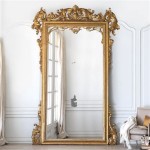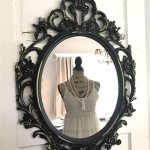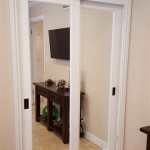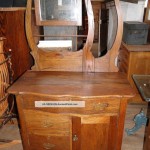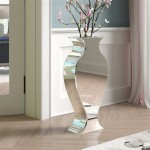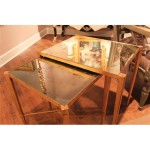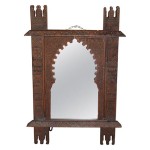Achieving Pottery Barn Style: DIY Mirror Alternatives
Pottery Barn is renowned for its classic and elegant home décor, and their mirrors are no exception. However, the price tag associated with these sought-after pieces can be prohibitive for many homeowners. Fortunately, achieving the same aesthetic appeal is possible through various do-it-yourself (DIY) projects and resourceful shopping strategies. Creating a Pottery Barn-esque mirror offers a personalized touch and significantly reduces expenditure. This article explores several methods for achieving the Pottery Barn mirror look without the Pottery Barn price.
Understanding the Pottery Barn Mirror Aesthetic
Before embarking on a DIY or alternative shopping endeavor, it’s crucial to understand the core characteristics of Pottery Barn mirrors. These mirrors often feature substantial frames, typically crafted from wood and finished in neutral tones such as white, gray, brown, or black. The frames often incorporate distressed details, adding a rustic or vintage charm. Beadboard accents, layered molding, and metallic finishes are also common design elements. Size is another defining factor, with many Pottery Barn mirrors being large statement pieces designed to create a focal point in a room. The overall design philosophy leans towards timeless elegance and understated sophistication.
Analyzing specific Pottery Barn mirror designs allows for a more targeted approach to replicating their style. For example, the Pottery Barn "Eagan" mirror features a simple, clean-lined frame with a beveled edge. Replicating this would involve focusing on clean cuts, a smooth finish, and potentially adding a beveled mirror edge yourself or sourcing a mirror with a pre-existing bevel. In contrast, the "Vintage Wood Framed Mirror" showcases a distressed wooden frame with visible knots and imperfections. Achieving this look would require sourcing reclaimed wood or strategically distressing new wood to mimic age and wear.
Material choices are also central to the Pottery Barn aesthetic. Wood, both solid and engineered, is a primary component. Finishes often include paint, stain, and combinations thereof. Metal accents, such as hinges or decorative corners, may also be incorporated. The quality of materials directly impacts the final product's appearance and durability; therefore, selecting appropriate materials is paramount when attempting a DIY replication.
DIY Mirror Frame Construction Techniques
One of the most direct ways to create a Pottery Barn-inspired mirror is to construct the frame yourself. This approach offers complete control over the design, materials, and finish. The first step involves selecting the type of wood and determining the dimensions of the frame. Pine is a readily available and affordable option, while more premium woods like oak or maple can provide a more sophisticated look. Accurately measuring the mirror is critical to ensure a snug and secure fit within the frame. It's important to account for a slight "reveal" of the mirror's edge for aesthetic purposes.
Once the wood is selected and cut to size, the frame can be assembled using various techniques. Miter joints, where the corners are cut at a 45-degree angle, provide a clean and seamless appearance. Butt joints, where the wood pieces are simply joined end-to-end, are a simpler alternative but may require additional reinforcement. Wood glue and clamps are essential for creating strong and durable joints. Depending on the size and weight of the frame, screws or nails may also be used for added stability.
After assembling the frame, the next step is to apply the desired finish. This can involve painting, staining, or a combination of both. Paint offers the most versatility in terms of color selection and allows for easy distressing techniques. Staining highlights the natural grain of the wood and creates a warmer, more traditional look. Applying multiple coats of paint or stain, followed by a protective clear coat, enhances durability and provides a professional finish. Sanding between coats ensures a smooth and even surface.
Distressing techniques can be employed to replicate the aged and weathered appearance often found in Pottery Barn mirrors. This can involve using sandpaper to strategically remove paint or stain, creating worn edges and exposing the underlying wood. Applying a dark wax or glaze and then wiping it away can accentuate details and add depth. Other distressing techniques include using a hammer or other tools to create dents and imperfections. The key is to apply these techniques sparingly and with intention, avoiding an overly contrived or artificial look.
Adding decorative elements such as beadboard, molding, or metal accents can further enhance the frame's aesthetic appeal. Beadboard can be applied to the inner portion of the frame, creating a textured and visually interesting border. Molding can be layered to add dimension and architectural detail. Metal corners or decorative hinges can contribute to a rustic or industrial vibe. These elements should be carefully chosen to complement the overall design and avoid overwhelming the mirror itself.
Repurposing and Upcycling Existing Mirrors
Another cost-effective approach involves repurposing or upcycling an existing mirror. This can be an old mirror with an outdated frame or a simple, frameless mirror that needs a makeover. The existing frame can be painted, stained, or distressed to achieve the desired Pottery Barn look. Alternatively, the frame can be removed entirely and replaced with a custom-built frame.
Thrift stores, flea markets, and garage sales are excellent sources for finding inexpensive mirrors suitable for upcycling. Look for mirrors with solid construction and interesting shapes or details. Even if the existing frame is damaged or unattractive, it can often be salvaged or incorporated into the new design. Consider the size and shape of the mirror and how it will fit into the intended space. Bring measuring tape to ensure the mirror is a suitable size before purchase.
If the existing frame is to be repurposed, surface preparation is crucial. This involves cleaning the frame thoroughly, removing any loose paint or varnish, and sanding to create a smooth surface. Primer may be necessary if the existing finish is glossy or difficult to adhere to. The frame can then be painted, stained, or distressed as desired. Consider using multiple colors or layering different finishes to create a unique and personalized look.
Adding reclaimed wood or architectural salvage to an existing mirror frame can create a one-of-a-kind piece with a vintage or rustic charm. Pieces of old barn wood, trim, or molding can be attached to the frame using wood glue and nails. The wood can be left in its natural state or finished with paint, stain, or wax. The key is to create a cohesive design that complements the existing mirror and enhances its overall aesthetic appeal. Consider the texture, color, and pattern of the reclaimed materials and how they will interact with the mirror's surface.
Frameless mirrors can be transformed into statement pieces by adding a custom-built frame. This offers complete control over the design and materials used. The frame can be constructed using the same techniques described previously, such as miter joints or butt joints. The mirror can be attached to the frame using mirror mastic or clips. Ensure the mirror is securely attached to the frame to prevent it from falling out. Safety is a significant concern when working with mirrors; always wear eye protection and handle the mirror carefully to avoid breakage.
Strategic Shopping for Affordable Alternatives
If DIY projects are not feasible or desirable, strategic shopping can be a viable alternative. Numerous retailers offer mirrors with similar styles to Pottery Barn at more affordable prices. Online marketplaces, discount home décor stores, and even big box stores can be valuable resources. The key is to be discerning and focus on pieces that capture the essence of the Pottery Barn aesthetic.
Comparison shopping is essential. Before committing to a purchase, compare prices from multiple retailers and consider the quality of materials and construction. Read online reviews to get a sense of other customers' experiences with the product. Look for sales, coupons, and promotional offers to maximize savings. Signing up for email newsletters or following retailers on social media can provide access to exclusive deals and discounts.
Focus on mirrors with similar frame styles and finishes as those offered by Pottery Barn. Look for frames made of wood, with neutral colors and distressed details. Consider the size and shape of the mirror and how it will fit into the intended space. Don't be afraid to mix and match different styles and finishes to create a unique and personalized look. Sometimes, a less expensive mirror's frame can be upgraded with paint or a new finish to closely mimic a desired Pottery Barn piece.
Consider purchasing unfinished mirrors and customizing them to achieve the desired look. Unfinished mirrors are typically less expensive than finished mirrors and offer a blank canvas for creativity. The frame can be painted, stained, or distressed to match the existing décor. Decorative elements such as beadboard, molding, or metal accents can also be added. This approach allows for complete customization while still being more affordable than purchasing a pre-finished mirror from Pottery Barn.
Online marketplaces like Etsy and eBay can be excellent sources for finding unique and affordable mirrors. Many artisans and small businesses sell handmade mirrors or repurposed vintage mirrors that capture the Pottery Barn aesthetic. Be sure to carefully review the seller's feedback and policies before making a purchase. Pay close attention to the dimensions, materials, and condition of the mirror. Ask the seller for additional photos or information if needed. Purchasing from a reputable seller can help ensure a positive shopping experience.

How To Make A Pottery Barn Knock Off Mirror Makely

Hi Friends How Are You Today I Thought It Would Be Fun To Do A Collection Of 50 The Bes Pottery Barn Dining Room Mirror Console

Pottery Barn Knock Off Mirror Easy Diy Chas Crazy Creations

House Stuff Works How To The Pottery Barn Knock Off Mirror

Pottery Barn Mirror Knock Off Project Tatertots And Jello

Diy Antiqued Panel Mirror Pottery Barn Inspired The Navage Patch

Diy Pottery Barn Brinkley Mirror Knockoff

Pottery Barn Mirror Knock Off Project Tatertots And Jello

How To Make A Pottery Barn Knock Off Mirror Makely

House Stuff Works How To The Pottery Barn Knock Off Mirror

